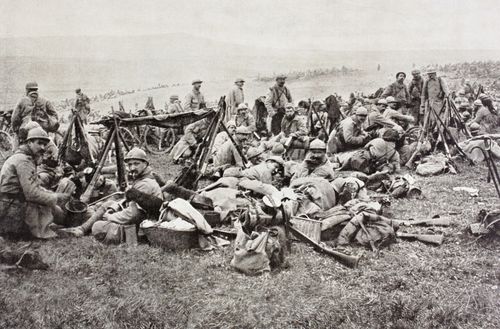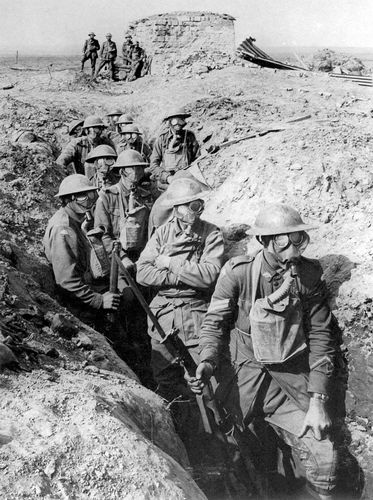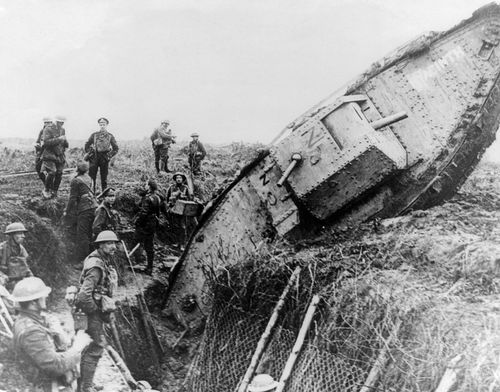In Flanders fields the poppies blow
Between the crosses, row on row,
That mark our place; and in the sky
The larks, still bravely singing, fly
Scarce heard amid the guns below.
We are the Dead. Short days ago
We lived, felt dawn, saw sunset glow,
Loved, and were loved, and now we lie
In Flanders fields.
Take up our quarrel with the foe:
To you from failing hands we throw
The torch; be yours to hold it high.
If ye break faith with us who die
We shall not sleep, though poppies grow
In Flanders fields.
John McCrae
First Battle of Ypres
In a series of fierce German attacks using their elite forces, brutal battles erupt at several key locations: Messines (October 12), Langemark (October 21-24), Geluveld (October 29-31), and Nonnenbossen near Hooghe (November 11). By November 22, a relative calm sets in, with the Germans just outside Ypres. The front line stretches across Bikschote, Langemark, Poelkapelle, east of Zonnebeke, Saint Eloi, Wijtschate, and east of Wulvergem.
The British defenders not only held Ypres but also thwarted the German advance toward the Channel. The cost was staggering: 58,155 British casualties (dead, wounded, or missing).
That winter, the Ypres sector remained relatively quiet, though on November 22, long-range German artillery heavily shelled the town, setting the historic Cloth Hall and Belfry ablaze. This marked the beginning of Ypres’ long four-year ordeal.
Read the story here and discover everything in our tour.


Second Battle of Ypres
In the spring of 1915, German forces advanced even closer to Ypres. The British had initially captured Hill 60 by detonating five mines but eventually lost it after fierce fighting. On April 22, the Germans launched a gas attack, advancing to capture Pilkem, Boesinghe-Sas, and Steenstraat. They overpowered French forces and seized part of the Ypres-IJzer canal. The British, particularly Canadian troops, were forced to withdraw from Wieltje and Hooge.
The Germans continued their attacks throughout May but failed to break through the British lines, suffering massive casualties. The British losses were also heavy, with 59,275 casualties.
For the next year, while the bulk of the German army was occupied elsewhere—at Verdun, the Somme, and Champagne—several small but significant skirmishes took place near Ypres, such as the Mont Sorrel battle (June 2-13, 1916). The Germans had heavily fortified their positions with concrete “pillboxes,” which gave them control over the town and its surroundings.
Until June 1917, the Ypres front remained relatively quiet.
The Second battle of Ypres is documented here.
Third Battle of Ypres
During the brief lull, the Germans fortified their positions around Ypres with hundreds of concrete blockhouses, creating a strong defensive line. Despite this, the British high command aimed to capture the ridges surrounding Ypres and break through toward the coast, where the German U-boat base at Zeebrugge posed a threat to Britain.
The offensive began with the successful capture of the Messines Ridge after months of preparation, with 19 mines simultaneously detonating, forcing the Germans to retreat by June 11.
The main offensive started on July 31, with the British advancing methodically over several months despite relentless rain and brutal conditions. For over three months, soldiers endured daily attacks and counterattacks. Finally, on November 6, 1917, the British captured Passchendaele. They secured areas such as the southern edge of Houthulst Wood, Poelkapelle, Zonnebeke, and parts of Beselare and Geluveld.
These limited territorial gains came at a heavy cost: nearly 270,000 British casualties. More on the Third Battle of Ypres here.

Join us on a battlefield tour today and secure your spot.